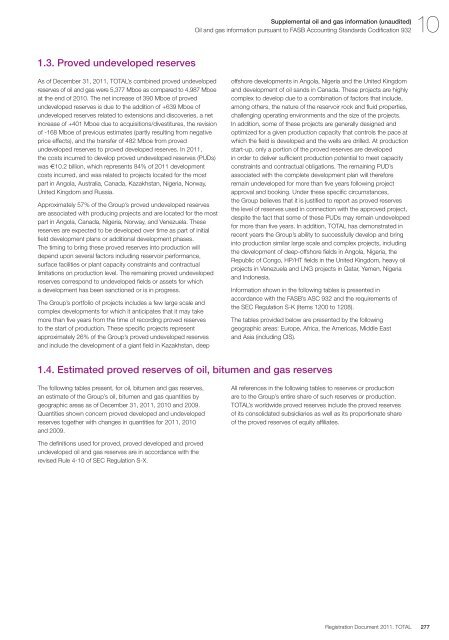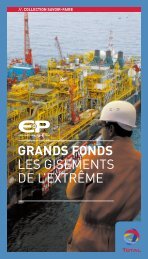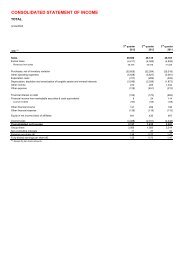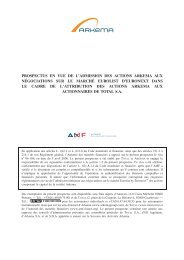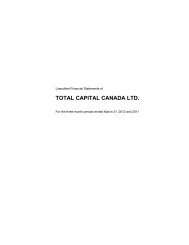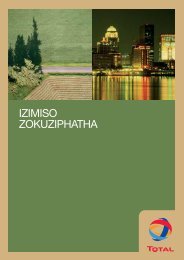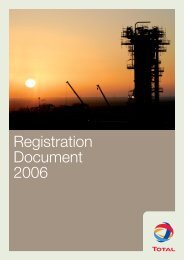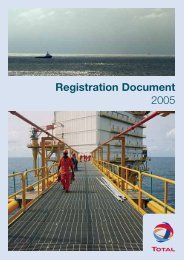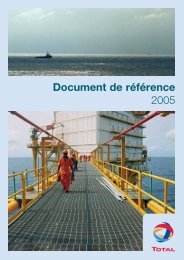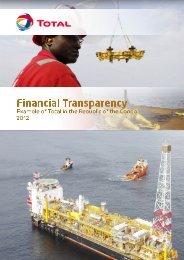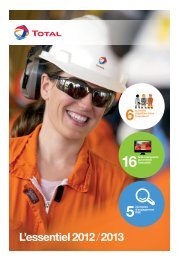Registration document 2011 - tota - Total.com
Registration document 2011 - tota - Total.com
Registration document 2011 - tota - Total.com
Create successful ePaper yourself
Turn your PDF publications into a flip-book with our unique Google optimized e-Paper software.
1.3. Proved undeveloped reserves<br />
As of December 31, <strong>2011</strong>, TOTAL’s <strong>com</strong>bined proved undeveloped<br />
reserves of oil and gas were 5,377 Mboe as <strong>com</strong>pared to 4,987 Mboe<br />
at the end of 2010. The net increase of 390 Mboe of proved<br />
undeveloped reserves is due to the addition of +639 Mboe of<br />
undeveloped reserves related to extensions and discoveries, a net<br />
increase of +401 Mboe due to acquisitions/divestitures, the revision<br />
of -168 Mboe of previous estimates (partly resulting from negative<br />
price effects), and the transfer of 482 Mboe from proved<br />
undeveloped reserves to proved developed reserves. In <strong>2011</strong>,<br />
the costs incurred to develop proved undeveloped reserves (PUDs)<br />
was €10.2 billion, which represents 84% of <strong>2011</strong> development<br />
costs incurred, and was related to projects located for the most<br />
part in Angola, Australia, Canada, Kazakhstan, Nigeria, Norway,<br />
United Kingdom and Russia.<br />
Approximately 57% of the Group’s proved undeveloped reserves<br />
are associated with producing projects and are located for the most<br />
part in Angola, Canada, Nigeria, Norway, and Venezuela. These<br />
reserves are expected to be developed over time as part of initial<br />
field development plans or additional development phases.<br />
The timing to bring these proved reserves into production will<br />
depend upon several factors including reservoir performance,<br />
surface facilities or plant capacity constraints and contractual<br />
limitations on production level. The remaining proved undeveloped<br />
reserves correspond to undeveloped fields or assets for which<br />
a development has been sanctioned or is in progress.<br />
The Group’s portfolio of projects includes a few large scale and<br />
<strong>com</strong>plex developments for which it anticipates that it may take<br />
more than five years from the time of recording proved reserves<br />
to the start of production. These specific projects represent<br />
approximately 26% of the Group’s proved undeveloped reserves<br />
and include the development of a giant field in Kazakhstan, deep<br />
1.4. Estimated proved reserves of oil, bitumen and gas reserves<br />
The following tables present, for oil, bitumen and gas reserves,<br />
an estimate of the Group’s oil, bitumen and gas quantities by<br />
geographic areas as of December 31, <strong>2011</strong>, 2010 and 2009.<br />
Quantities shown concern proved developed and undeveloped<br />
reserves together with changes in quantities for <strong>2011</strong>, 2010<br />
and 2009.<br />
The definitions used for proved, proved developed and proved<br />
undeveloped oil and gas reserves are in accordance with the<br />
revised Rule 4-10 of SEC Regulation S-X.<br />
Supplemental oil and gas information (unaudited) 10<br />
Oil and gas information pursuant to FASB Accounting Standards Codification 932<br />
offshore developments in Angola, Nigeria and the United Kingdom<br />
and development of oil sands in Canada. These projects are highly<br />
<strong>com</strong>plex to develop due to a <strong>com</strong>bination of factors that include,<br />
among others, the nature of the reservoir rock and fluid properties,<br />
challenging operating environments and the size of the projects.<br />
In addition, some of these projects are generally designed and<br />
optimized for a given production capacity that controls the pace at<br />
which the field is developed and the wells are drilled. At production<br />
start-up, only a portion of the proved reserves are developed<br />
in order to deliver sufficient production potential to meet capacity<br />
constraints and contractual obligations. The remaining PUD’s<br />
associated with the <strong>com</strong>plete development plan will therefore<br />
remain undeveloped for more than five years following project<br />
approval and booking. Under these specific circumstances,<br />
the Group believes that it is justified to report as proved reserves<br />
the level of reserves used in connection with the approved project,<br />
despite the fact that some of these PUDs may remain undeveloped<br />
for more than five years. In addition, TOTAL has demonstrated in<br />
recent years the Group’s ability to successfully develop and bring<br />
into production similar large scale and <strong>com</strong>plex projects, including<br />
the development of deep-offshore fields in Angola, Nigeria, the<br />
Republic of Congo, HP/HT fields in the United Kingdom, heavy oil<br />
projects in Venezuela and LNG projects in Qatar, Yemen, Nigeria<br />
and Indonesia.<br />
Information shown in the following tables is presented in<br />
accordance with the FASB’s ASC 932 and the requirements of<br />
the SEC Regulation S-K (Items 1200 to 1208).<br />
The tables provided below are presented by the following<br />
geographic areas: Europe, Africa, the Americas, Middle East<br />
and Asia (including CIS).<br />
All references in the following tables to reserves or production<br />
are to the Group’s entire share of such reserves or production.<br />
TOTAL’s worldwide proved reserves include the proved reserves<br />
of its consolidated subsidiaries as well as its proportionate share<br />
of the proved reserves of equity affiliates.<br />
<strong>Registration</strong> Document <strong>2011</strong>. TOTAL 277


